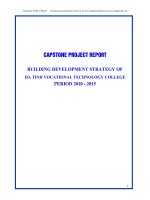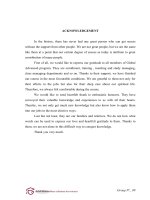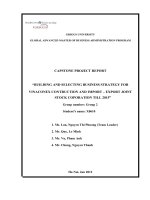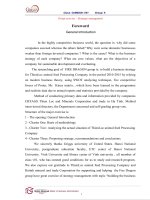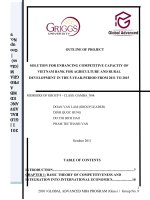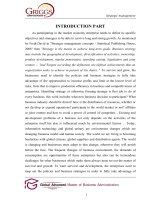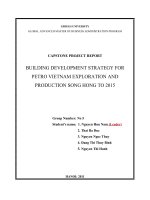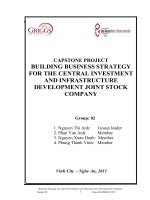Luận văn thạc sĩ quản trị kinh doanh quốc tế MBA (130)
Bạn đang xem bản rút gọn của tài liệu. Xem và tải ngay bản đầy đủ của tài liệu tại đây (507.01 KB, 84 trang )
Class: GeMBA01.V01
Group: 9
Group exercise - Strategic management
Foreword
General Introduction
In the highly competitive business world, the question is: why did some
companies succeed whereas the others failed? Why were some domestic businesses
weaker than foreign invested companies ? What is the cause? What is the business
strategy of each company? What are core values, what are the objectives of a
company for sustainable development and everlasting.
The researching goal of FIRE DRAGON group is: to build a business strategy
for ThienLoc animal feed Processing Company in the period 2010-2015 by relying
on modern business theory, using SWOT analyzing technique, five competitive
forces of Porter, Mc Kiney matrix…which have been learned in the programme and
realistic data due to annual reports and statistics provided by the company.
Method of conducting primary data and information provided by companies
CBTAGS Thien Loc and Minerals Corporation and trade in Ha Tinh. Method
interviewed directors, the Department concerned and self-grading group vote.
Structure of the major exercise is:
1 - The opening: General Introduction
2 - Charter One: Basis of methodology
3 - Charter Two: Analyzing the actual situation of ThienLoc animal feed Processing
Company
4 - Charter Three: Proposing strategy, recommendations and conclusions.
We sincerely thanks Griggs university of United States. Hanoi National
University, postgraduate education faculty, ETC center of Hanoi National
University. Vinh University and library center of Vinh university , all member of
class v01, who has created good conditions for us to study and research program.
We also express our gratitude to ThienLoc animal feed Processing Company and
Hatinh mineral and trade Corporation for supporting and helping the Fire Dragon
group have great exercise of strategy management with topic “building the business
1
Class: GeMBA01.V01
Group: 9
Group exercise - Strategic management
strategy for ThienLoc animal feed Processing Company in the period 2010-2015”
to-present-today.
The proposed business strategy : Move
2
to a new height.
Class: GeMBA01.V01
Group: 9
Group exercise - Strategic management
Charter One
Basis of methodology
On the competitive aspect, we will use the capacity of making a difference
to describe the special ability, creating a certain advantage. The ability to create
differences includes special abilities, skills, technologies and resources for an
organization in order to make the difference with competitors and create
competitive advantage ideally , capabilities and skills of an organization to make so
much difference that other competitors can not copy. Capabilities and skills of
evaluation in business includes activities such as: product design, manufacturing
innovation with low-cost, technology rights, outstanding quality, delivery efficiency.
Thus, to survive every enterprise must have a few areas of activity or skill lead to
competitive advantage.
I. THE THEORY OF BUSINESS STRATEGY
Strength
Chances
To
maintain
To discover
Strategy
Internal
External
To Prevent
ToEncounter
threats
Weak
points
Figure 1.1. Business strategy
3
Class: GeMBA01.V01
Group: 9
Group exercise - Strategic management
Definition:
Strategy is a series of complex actions to mobilize resources
that an organization can have to achieve a certain goal.
In 1962, the Chandler defined strategy as "the determination of the longterm objectives and purposes of a business on the application of a series of actions
as well as the allocation of resources needed to implement the goal.
Chandler, A (1962) Strategy and structure Cambridge, Massachusetts, MIT
Press.
"Strategy is the long term direction and scope of an organization to gain
competitive advantage for the organization through the format of its resources in the
changing environment, to meet market demand and meet expectations of
stakeholders.
Johnson, GI, Choles, K.
(1999) Exploring Corporate Strategy, 5th Ed
Prentice Hall Europe.
In defining strategies to Mintzberg's 5 P-word Essential aspects of strategic
management as follows:
Plan (plan): series of actions to be intended consistently
Pattern (pattern): consistency of behavior over time, may be intended or not
intended.
Position (Position): Match between the organization and its environment.
Concept (Perspective): How to deep recognition of the world.
Tricks (Ploy): How to fool the opponent.
1.1. Business Strategy:
1.1.1. Business Strategy is the art.
4
Class: GeMBA01.V01
Group: 9
Group exercise - Strategic management
- Alain Threlart said that "Strategy is the art that businesses use to compete
against and win victory.
M. Porter said that "Strategy is the art of building competitive advantage for
a firm defense.
Thus, these authors considered that the business strategy is the art to
compete on the market and develop business.
1.1.2. In the opinion of management category, business strategy is a form of
the plan.
- G. Arlleret said that "Strategy is the determination of roads and other
means to reach the goals identified through the policy.
- D. Bizrell and his group of authors said that "strategy is like a general plan
leading or direct enterprise to the desired target. It is the basis for the policies and
the working methods
- Glueck said that "Strategy is a kind of uniform, comprehensive and
integrated plan designed to ensure that the objectives of the business will be done."
1.1.3. In the opinion of the combination of unity:
- "Business Strategy is the art of coordinating activities and control them in
order to reach long-term goals of the enterprise.
- Chandler considered “strategy implies the stability of the basic long-term
goals of the business, and selection of the way or process of action and distribution
of essential resources and organizing to implement the goals.
- In business "business strategy is an art to design and organize the means to
reach the long-term goals of the business and have relationship with the
transformation of the business environment and competition.
5
Class: GeMBA01.V01
Group: 9
Group exercise - Strategic management
1.2. Competitive strategies according to M.Porter opinion.
Michael E. Porter-professor of Harvard University presented basic
competitive strategies in his work “competitive strategies”.
1.2.1.Leading low-cost strategy
This strategy creates competitive advantage in two ways:
- Underestimate competitors in the industry aimed at attracting target
customers who are sensitive to price to increase total revenue. This strategy is
consistent with large-scale business units which can reduce costs in the process of
operation.
- Refrain entirely cut off, content with the current market share and use the
lower cost to have higher net profit per sold unit of product.
1.2.2. Different strategy
Business unit will focus on creating diferent kinds of products and
marketing programs from those of its competitors to reach the leading sector. Since
then fixing prices higher than other conventional products, increasing sales by
attracting customers who like brand with highlight features such as a unique taste,
the ability of available reservation for distribution to customers in anywhere,
scientific applications in the design and operation of implementation, optimal
service, high quality, reputation and distinctive ...
1.2.3. Strategy focuses on main point:
According to this strategy, the business unit focuses its attention on the
narrow segment of the entire market. The segment can be defined by geographic
area, products and customers. The attractive segments to be chosen is where no
competitors or rivals meet the needs and expectation of customers.
6
Class: GeMBA01.V01
Group: 9
Group exercise - Strategic management
1.3. Competitive strategies are applied for business units according to
market share position in the market
In the same company but each business unit has a different market share
in the market
1.3.1. Leading business unit in the market:
– Strategy to expand total demands: Searching for a new region for sales,
finding new customers, developping new uses and encouraging greater use of the
product.
– Strategy for defense: Helping leading business unit in the market hold its
position in current market. Leading units in the market are always threatened by
other competitors, especially those units that keep challenging positions for the
market. Therefore, business unit have to continuously defend against attacks by
competitors.
- Strategy to expand market share: By buying back or snatching business
units of small competitors, attack to occupy market share of major competitors.
1.3.2. Provocative business units to the market :
Attacks on leading business units and other competitors to increase market
share or business can be parallel to the competition and do not touch to behind
competition. To make attack strategy, the business unit must perform the following
steps:
- Clearly define the competitors to attack and goal of attack strategy.
- Select appropriate strategy to attack: attack forward, attack the flank, siege
attack ...
1.3.3. Business unit follows the market:
7
Class: GeMBA01.V01
Group: 9
Group exercise - Strategic management
These are the business units that do not want to cope with the leading
competition or challenge of the market because of insufficient resources, fear of
loss, loss of many costs ... so they try to evade by following leading rivals in the
market through simulation strategies:
– Complete simulation of products, distribution method, advertising and
marketing activities, supplying products to sensitive target market with low price.
- Simulating some main contents in the mixed marketing of leading rivals
led and keeping some differences in packaging, pricing, advertising, sales
network ...
- Improved simulation is to adapt to the market by basing on marketing mix
of market leading opponent to improve and make specific characteristics for its
marketing mix to adapt to the needs and wishes of the goal market.
1.3.4. Binisess unit hides in the market
The business units which hide in the markets always find one or several safe
and profitable segmentso hide. To succeed on narrow market segments, they often
implement typical specialization strategies:
- Specialize in the final user: Depending on the industry, lurking business
units choose a kind of customers who have damand of its product anf services to
serve.
- Expertise in stages in the process of production and distribution of
products.: The business unit can choose the details, components of a finished
product, one addition product to the main product.
- Specialize in customer: Select customers according to demographic criteria
to serve customers with high, medium or low incomes or such clients as children,
teenagers, youth ...
8
Class: GeMBA01.V01
Group: 9
Group exercise - Strategic management
- Expertise in sale zones: Select a geographic area to serve such as domestic,
local markets, regional markets...
- Specialize in features of products: high, luxurious or average quality.
- Specialize in items of each field: one or several items in major industries.
- Specialize in business services options that competitors do not offer.
1.4. Process to formulate strategies
Building business strategy is the first period in process of strategic
management.
1.4.1 Assessment of outside environment.
Environment of an organization includes the factors, forces, the
institutions... outside the business that administrators do not control them but they
affect the operation and performance of the business.
Environment of the
organization can be divided into two levels: the macro environment, microenvironment.
Macro environment affects all businesses, but it is not necessary in a certain
way, including:
(1) Economic environment;
(2) Environment of Law, government and politics;
(3) Cultural-social environment
(4) Natural environment;
(5) Technological environment.
Micro-environment is defined for a specific industry. Enterprises in the
industry are affected by the micro environment of the industry, including:
9
Class: GeMBA01.V01
Group: 9
Group exercise - Strategic management
(1) competitors;
(2) customers;
(3) suppliers;
(4) potential rival;
(5) Spare products.
Analysis of outside factors is qualitative, intuitive and hard to imagine. In
strategic management, the researchers offer two tools for enterprise to grade and
measure the effects of the environment to the operation of the business. This is
matrix which assess outside factors (EFE) and competitive image matrix.
1.4.2 Assessing the internal situation of the business.
Internal situation of the enterprise is usually evaluated by functional areas
such as Finance; Human Resource, operation management; Organization structure;
Marketing, Research / Development; Technology Information.
Analysis inside enterprises will allow to recognize strengths (S) and
weaknesses (W) of the enterprise. Since then, the business strategy has been
selected to maximize the strengths and overcome the weaknesses of the business.
It is also similar in technical analysis of the external factors, in order to
measure the analysis of the internal situation of the business, they usually use "
matrix of internal evaluation” (IFE).
1.5. Tools to build business strategy
According to Fred R. David, there are three stages to form business strategy
and each stage uses different tools.
Phase 1: Phase of collecting and systematizing information
10
Class: GeMBA01.V01
Group: 9
Group exercise - Strategic management
This phase sums up basic informations that were collected and systemized to
form the business strategy. This phase uses three tools: EFE Matrix, the collective
picture matrix and IFE matrix.
Phase 2: Phase of matching
This phase selects, arranges and combines external environmental factors,
internal factors to make the feasible strategies. This phase will use tools of matrix:
strength – weakness, opportunities - challenges matrix(SWOT);
Strategic position and activities evaluation matrix (SPACE) and large
strategy matrix.
Phase 3: Phase of decision
This stage uses a single tool, the quantified strategy planning matrix
(QSPM). QSPM uses information in stage 1, objectively evaluate business strategic
which can be chosen in phase 2 to decide which strategy is optimal for the business.
1.5.1 Phase of collecting and systematizing information
1.5.1.1 EFE Matrix
EFE matrix is set up by five sequential steps:
- Step 1: Making the list of factors that have decisive role in industry of the
business, including opportunities and challenges.
- Step 2: Assessing the importance of each factor according to a scale of 0.0
to 1.0 (increasing level of importance) with a total score of the factors by 1. The
level is based on business industry in which the enterprise operates.
- Step 3: Recording from 1 to 4 for each factor with the mark that shows the
level of response of business to that factor. Mark 4 is good response. Mark 3 is over
average reaction. Mark 2 is the average response and mark 1 is little response.
11
Class: GeMBA01.V01
Group: 9
Group exercise - Strategic management
- Step 4: Determining the total mark for each factor ( equal to product in
step 1 and 2).
- Step 5: Determining the total mark of the importance of the business by the
total mark in step 3.
Highest total mark is 4 and the lowest is 1. Average one is 2.5. Higher mark
shows that business responded well to external factors.
1.5.1.2 Competitive picture matrix
This matrix identifies the major competitors of the enterprise. This matrix is
an extension of the EFE matrix with the important levels of other factors, mark
meaning of each factor and total mark that is important to have the same meaning.
Competitive picture matrix is different from EFE matrix in that: there are
some internal elements having decisive importance decisions also to be used for
comparison. Total mark to evaluate competitors will be compared to the business
that is chosen as samples.
1.5.1.3 IFE matrix
The IFE matrix is set up by the following steps:
Step 1 – Setting up list of decisive factors.
Step 2 - Assessing the importance of each factor according to scale of 0.0 to
1.0 (increasing level of importance) with a total mark of elements equal to 1. The
importance is based on the importance of those factors for the business, not to
discriminate these factors as the strengths or weaknesses of the business.
Step 3 – To mark from 1 to 4 for each factor with grade that shows the
internal features of the business for that element. Mark 1 is the biggest weakness,
mark 2 is the smallest weakness, mark 3 is the smallest strength, mark 4 is the major
strength.
12
Class: GeMBA01.V01
Group: 9
Group exercise - Strategic management
Step 4-Determining the total mark for each factor ( equal to product in step 1
and 2).
- Step 5: Determining the total mark of the importance of the business (equal
to the total mark in step 4).
Highest total mark is 4 and the lowest is 1. Average one is 2.5. The mark of
importance is lower than 2.5 indicates the internal weakness of the business, the
mark is higher than 2.5 indicates the internal strength of the business.
1.5.2 Phase of matching
1.5.2.1 SWOT Matrix
SWOT matrix is a tool of combining the strengths (S), weaknesses (W),
opportunities (O) and threats (T) to form four types of strategies:
- SO Strategy: Using strengths within the business to exploit the
opportunities of the external environment.
- WO Strategy: Taking advantage of external opportunities to improve the
intrnal weaknesses.
- ST Strategy: Using strengths of the business to avoid or reduce the threats
from the outside environment.
– WT Strategy: This is the defensive strategy to reduce the weaknesses and
external threats.
13
Class: GeMBA01.V01
Group: 9
Group exercise - Strategic management
A SWOT matrix is illustrated by the crossword as follows:
O
S
W
Listing the
Listing the
strengths
weaknesses
SO strategies
WO Strategies
ST strategies
WT Strategies
Listing the
opportunities
T
Listing the threats
Figure 1.2
1.5.2.2 Space Matrix
Space matrix includes two internal factors: the financial strength (FS) and
competitive advantage (CA), two external factors: environmental stability (ES) and
the industrial strength ( IS).
SPACE matrix is built through the steps:
- Selecting a group of variables which represent the FS, CA, ES and IS.
- Assigning values from 1 (worst) to 6 (best) for FS and IS, from -1 (best) to
-6 (worst) to ES and CA.
– To grade average score for FS, IS, ES and CA.
– To mark the average score for each aspect.
– Adding 2 points on the horizontal axis and check the results, adding 2
points on the vertical axis and check results. To mark co-ordinate of new point.
14
Class: GeMBA01.V01
Group: 9
Group exercise - Strategic management
-Drawing a direction vector from original point to this new point:
FS
Offensive strategy
Prudent strategy 6
5
4
3
2
1
CA -6 -5 -4 -3 -2 -1
0 1 2 3 4 5 6 IS
-1
-2
-3
-4
Defensive strategy
-5
-6
Competitive strategy
ES
Figure 1.3 Space Matrix
15
Class: GeMBA01.V01
Group: 9
Group exercise - Strategic management
If the vector is located in the origin of attack: the company is in the best
position to use the internal strengths.
Strategies: market penetration, market
development, product development, forward combination, back combination,
horizontal combination are possible for each specific situation of each enterprise.
If the vectors is located in origin of cautious: the business should work
with its basic capabilities but not so desperate.
market penetration, market
development, product development and concentrated diversification.
If the vector is located in the origin of defense: the enterprise should focus
on improving weaknesses and avoid the dangers from outside. Defense strategies:
spending limit, removation, liquidation and concentrated diversification.
If the vector is located in the origin of competition: competitive strategies
can be forward combination, back combination, horizontal combination, market
penetration, market development, product development and participation in joint
ventures.
1.5.2.3 Major strategic matrix
Matrix includes: the horizontal axis shows the competitive position of the
enterprise on the market (strong or weak) and vertical axis shows the growth of the
market (fast or slow). The appropriate strategies are listed in each square cornerbelow:
Quick
16
Class: GeMBA01.V01
Group: 9
Group exercise - Strategic management
Corner II
Corner I
1. Market Development
1. Market Development
2. Market access
2. Market access
3. Product Development
3. Product Development
4. Horizontal Combination
4. Forward combination
5. Renovation
5. Back combination
6. Liquidation
6. Horizontal Combination
7. Concentrated diversification
Strong
Weak
Corner III
Corner IV
1. Spending reduction
1. Concentrated diversification
2. Concentrated diversification
2. Horizontal diversification
3. Horizontal diversification
3. Association diversification
4. Association diversification
4. Joint Venture
5. Remove
6. Liquidation
Slow
Figure 1.4: Major strategyic matrix
1.5.3 Decisive Stage
17
Class: GeMBA01.V01
Group: 9
Group exercise - Strategic management
QSPM matrix uses information obtained from the three matrixes in stage 1
(the stage to collect and systematize information) and 3 matrixes in phase 2 (phase
of matching), thereby evaluates replaceable business strategy objectively.
Strategies which are selected for QSPM matrix are not all strategies found in
Stage 2.
To build the matrix QSPM, it is necessary to make 6 steps:
- Step 1: Listing the factors S, W, O, T that is taken from EFE, IFE Matrix.
- Step 2: Sorting suitable elements for EFE, IFE Matrix.
- Step 3: Researching the matrixes in stage 2 and identifying alternative
strategies that may need to consider.
- Step 4: Determining the mark of attractions (TAS) for each element: at e
been evaluated from 1 to 4, with 1 is not attractive, compelling some two, three
attractive, four very attractive .
- Step 5: As the total number of attractions (TAS) for each rank by
multiplying the mark of classification in step 2 with AS mark in step 4.
- Step 6: Calculating total mark of attractions in each strategy.
The most attractive strategy is the strategy with highest total mark in step 6
1.6. Basic characteristics of the business strategy.
1.6.1. THE BUSINESS STRATEGY determines which the fundamental goals are
the business direction of the enterprise in each period.
1.6.2. The orientation of the strategy is to ensure continuous and firm development
of the business in a constantly fluctuating business environment.
18
Class: GeMBA01.V01
Group: 9
Group exercise - Strategic management
1.6.3. THE BUSINESS STRATEGY ensures maximum mobilize and optimal
combine exploitation and use of resources of the enterprise, in the present and
future, to promote the advantages and seize the opportunity to gain advantage in
competition.
1.6.4. Business strategy of the business is reflected throughout the process
continuously.
1.6.5. THE BUSINESS STRATEGY always has thought of advancing, winning
victory in the business market.
1.6.6. THE BUSINESS STRATEGY is usually built in a long time (3; 5; 10 years).
1.7. Strategic vision and strategy mission:
1.5.1. Strategy vision refers to the future business direction of the company "Where
are we going to?”
- The markets should be pursued.
- Focus on technology - products – clients in the future.
1.5.2. Mission statement of most companies focus on present business "Who are
we and what we do”.
- Current products and services.
– customer demands should be served.
1.8. The mission of the enterprise.
- Orientation to customers.
-
Define major scope and business.
19
Class: GeMBA01.V01
Group: 9
Group exercise - Strategic management
Who should be
satisfied?
Who should
be satisfied?
Group of customers
Customer demand
Define field of
business
Which demand is
sastisfied?
Technology to meet
Figure 1.3. Three-dimensional frame of D. Abell
20
Class: GeMBA01.V01
Group: 9
Group exercise - Strategic management
1.9. To define objectives
.
Figure 1.5
1.10. Human Resource Management
* Overview.
Assets of human capital: is the sum of the qualities, experience, knowledge,
creativity, energy and enthusiasm that people that invest in their work.
- Human capital management (HCM): the effort to discover what is best for the
organization.
- Human Resource Management (HRM): the use of the individual to achieve the
objectives of the organization, includes five main functions.
- Human resources development: not only includes the training and retraining, but
also planning for career and personal fostering, organizational development and
evaluation of performance.
1.11. Enterprise Financial Management
21
Class: GeMBA01.V01
Group: 9
Group exercise - Strategic management
We have reviewed the operation of financial markets and found that these
markets offer ways of combination of investors (who save) and users of capital
(businesses provide products and services to customers). The financial markets are
factors that determine value of a business, and it is supposed that our goal is to
maximize the value of the shares, without any more fundamental factor for our
research like the financial markets. Accounting is the language of finance. Basic
financial statements include reports of business results, balance sheet reports cash
flow. Firstly, we will evaluate the basic model of the financial statements of the
business and particularly focusing on cash flow report.
This report is very
important in financial analysis because it focuses on money rather than income or
profits.
Our discussion of financial indicators incorporates four targets of
indicators: solvency of the business, profitability, financial decisions and profit rate
on capital stock. We combine analysis of financial statements with an overview of
indicator approach and analysis which is also known as the Dupont analysis.
1.12.Management of production and work
Production and work management includes all activities related to the
management of inputs and organizing, coordinating these factors in order to convert
them to the most effective material or service products.
To convert
inputs
- Human resourse
- Materials
- Technology
- Machinery
- Capital
- Management Science and technology
outputs
- Altering
- Adding value
Feedback
Figure 1.11. Process of production management
22
- Goods
- Services
Class: GeMBA01.V01
Group: 9
Group exercise - Strategic management
1.13 Marketing Management:
Success in business often starts from the satisfaction of customer, as much as
possible. Marketing is an endless source of inspiration and a place where we can go
back many times to search for ideas and strategies to help us exist in storm of
competition in the market
23
Class: GeMBA01.V01
Group: 9
Group exercise - Strategic management
CHAPTER II:
ANALYSING THE SITUATION OF THIEN LOC ANIMAL FEED
PROCESSING COMPANY
2.1 INTRODUCTION
Fig 2.1
24
Class: GeMBA01.V01
Group: 9
Group exercise - Strategic management
2.1.1. Geographical position of Thien Loc Animal Feed Processing
Company
Thien Loc Animal Feed Processing Company is located in the East of 1A
highway and the East of Nghen river, far 700 m from Ha Vang bridge to the South,
far 25 km from Ha Tinh city, far 25 km from Vinh City, Nghe An province;
belonging to Can Loc town, Can Loc District, the area of the company is 50.000 m 2.
2.1.2. Introducing the history of Thien Loc Animal Feed Processing
Company
- Thien Loc Animal Feed Processing Company and Breeding Company are the
units that belong to Ha Tinh Minerals and Trading Corporation, they are established
on the strong financial basis. These are the units that are established on the basis of
the project “Applying the advanced technology in manufacturing and breeding,
processing feed with ensuring environmental sanitation to make super-lean pig
variety with high quality, in accordance with ecological condition of Ha Tinh”.
- Manufacturing scale:
Manufacturing feed with powder form and tablet form
Including:
- Feed with powder form: 20 tonnes/hour
- Feed with tablet form: 10 tonnes/hour
The factory’s capacity: 120,000 tonnes/year.
The factory specializes in manufacturing types of feed for breeding pigs,
cows, chickens, ducks, fishes. They are manufactured on advanced manufacturing
line that bases on American technology, the Company has good technical specialists
with many experiences in feed manufacturing branch inland and abroad as:
Thailand, Holland, China,…
2.1.3. Organizational structure.
25
